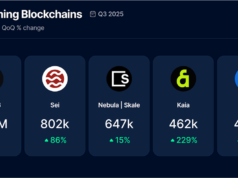The Philippines, a nation already embracing digital payments with gusto, is poised to become a major testing ground for web3 adoption. Ronin, the blockchain behind the popular game Axie Infinity, is partnering with Coins.ph to integrate its peso-backed stablecoin, PHPC, into the country’s national QR payment system, QRPH.
If regulators give the green light, this move could put PHPC in the hands of millions, usable at over 600,000 merchants nationwide. It’s a bold step toward bridging the gap between the crypto gaming world and everyday commerce.
Ronin’s vision extends far beyond the digital battlefields of its games. The company unveiled its plans at the YGG Play Summit, signalling a desire to become a key player in the broader Asia-Pacific financial landscape. Think of it as Ronin evolving from a gaming platform into a versatile financial tool.
The integration would allow Ronin Wallet users to scan QRPH codes, much like they would with popular mobile wallets. However, instead of relying on traditional banking rails, these transactions would settle directly on the blockchain, offering potential benefits in speed and transparency.
The timing couldn’t be better. Digital payments are booming in the Philippines, now accounting for over half of all retail transactions, according to the Bangko Sentral ng Pilipinas. Person-to-merchant digital payments are leading the charge.
Couple this with the Philippines’ status as a top recipient of remittances, and you have a population ripe for innovative digital payment solutions. The demand for flexible, borderless financial tools is undeniable.
Coins.ph CEO Wei Zhou is optimistic, projecting a potential launch as early as 2026, contingent on securing the necessary regulatory approvals. The aim is to provide Ronin Wallet users with a seamless payment experience, mirroring the simplicity of existing digital wallets.
But here’s the kicker: unlike those wallets, PHPC transactions would benefit from on-chain settlement, offering a level of transparency and efficiency that traditional systems can’t match. This is where the promise of web3 truly shines.
PHPC’s journey began in 2024 within the BSP’s sandbox program. Pegged 1:1 to the Philippine peso, it’s managed by Coins.ph under the watchful eye of the BSP. Its launch created a critical link between the Ronin gaming ecosystem and the real world.
Imagine earning digital assets playing games like Axie Infinity and then using those earnings to buy groceries or pay bills. That’s the vision. This integration makes that vision a tangible possibility.
“This integration moves the ecosystem closer to a future foreshadowed during the pandemic, when some merchants began informally accepting in-game tokens,” notes Sky Mavis Co-Founder Jeffrey Zirlin.
He’s referring to a time when necessity bred innovation, and merchants started accepting in-game currency as payment. Now, with a regulated stablecoin and a robust payment infrastructure like QRPH, that informal system can evolve into something far more secure and widespread.
Ronin Wallet remains a dominant force in the web3 gaming space, boasting millions of active users. By integrating with QRPH, Ronin isn’t just expanding its reach; it’s redefining its purpose.
It’s a strategic move to position itself not just as a gaming platform but as an integral part of daily financial life, all while navigating the complex world of regulatory compliance. The future of web3 adoption may well be written in the QR codes of the Philippines.
Keep an eye on Coins.ph’s official Facebook page and the Ronin X account for updates as this ambitious plan progresses through the regulatory maze.



